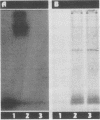Abstract
The association of heat-stable enterotoxin (STa) produced by enterotoxigenic Escherichia coli 431 with isolated rat intestinal epithelial cells and brush border membranes was characterized. Specific binding of strain 431 125I-STa to a single class of specific high-affinity receptors was saturable and temperature dependent and reached a maximum between 5 and 10 min. A 1,000-fold excess of unlabeled 431 STa competitively displaced 90 to 95% of radiolabeled enterotoxin bound to brush border membranes. In contrast, specific binding of 431 125I-STa to intestinal cells ranged from 40 to 65%. The number of STa-specific receptors on rat intestinal cells determined by Scatchard analysis was 47,520 +/- 14,352 (mean +/- standard error of the mean) per cell, with affinity constants (KaS) of 2.55 X 10(11)and 4.32 x 10(11) liters/mol determined for intestinal cells and brush border membranes, respectively. Villus intestinal cells appeared to possess about twice as many STa receptors as did crypt cells. Dissociation of specifically bound 431 125I-STa from intestinal cells and brush border membranes was minimal (2 to 5%). In addition, neither the rate nor the extent of dissociation was increased by a 1,000-fold excess of unlabeled homologous 431 Sta. Binding experiments with 431 125I-STa and brush border membranes showed that purified unlabeled STas from enterotoxigenic E. coli strains 667 (class 1 porcine enteropathogen), B-41 (bovine enteropathogen), and human strains 213C2 (Mexico) and 153961-2 (Dacca, Bangledesh) exhibited patterns of competitive inhibition similar to those of homologous unlabeled 431 STa (class 2 enteropathogen). A lipid extract which contained gangliosides and glycolipids exhibited dose-dependent competitive inhibition of heat-labile enterotoxin binding to brush border membranes but did not inhibit binding of 431 125I-STa. Purified heat-labile enterotoxin from strain 286C2 did not inhibit binding of 431 STa to brush border membranes. Pronase treatment of brush border membranes reduced binding of 431 125I-STa by about 30%, suggesting that the STa receptor was a protein or a glycoprotein. The putative STa receptor was radiolabeled with 431 125I-STa and solubilized with sodium deoxycholate. One major radioactive band was detected by sodium dodecyl sulfate-polyacrylamide gel electrophoresis, followed by radioautography. These data suggested that STas bind essentially irreversibly to a specific receptor on the cell surface of intestinal cells before activation of guanylate cyclase.
Full text
PDF

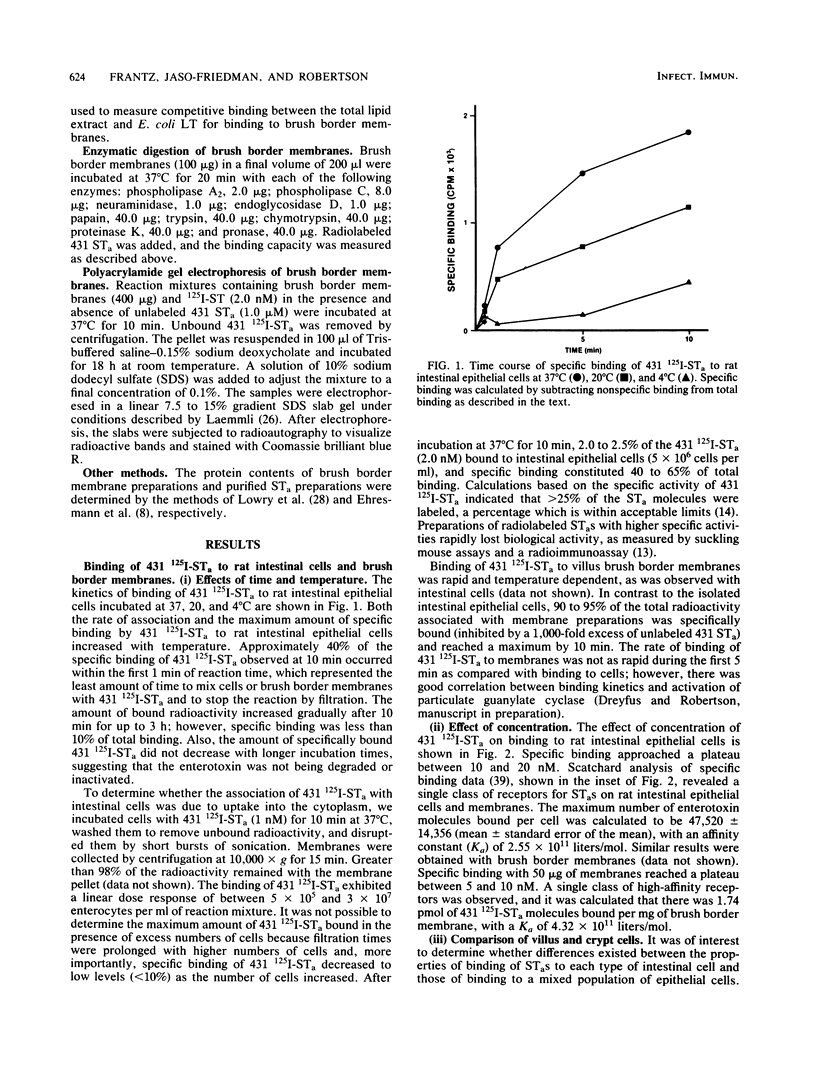

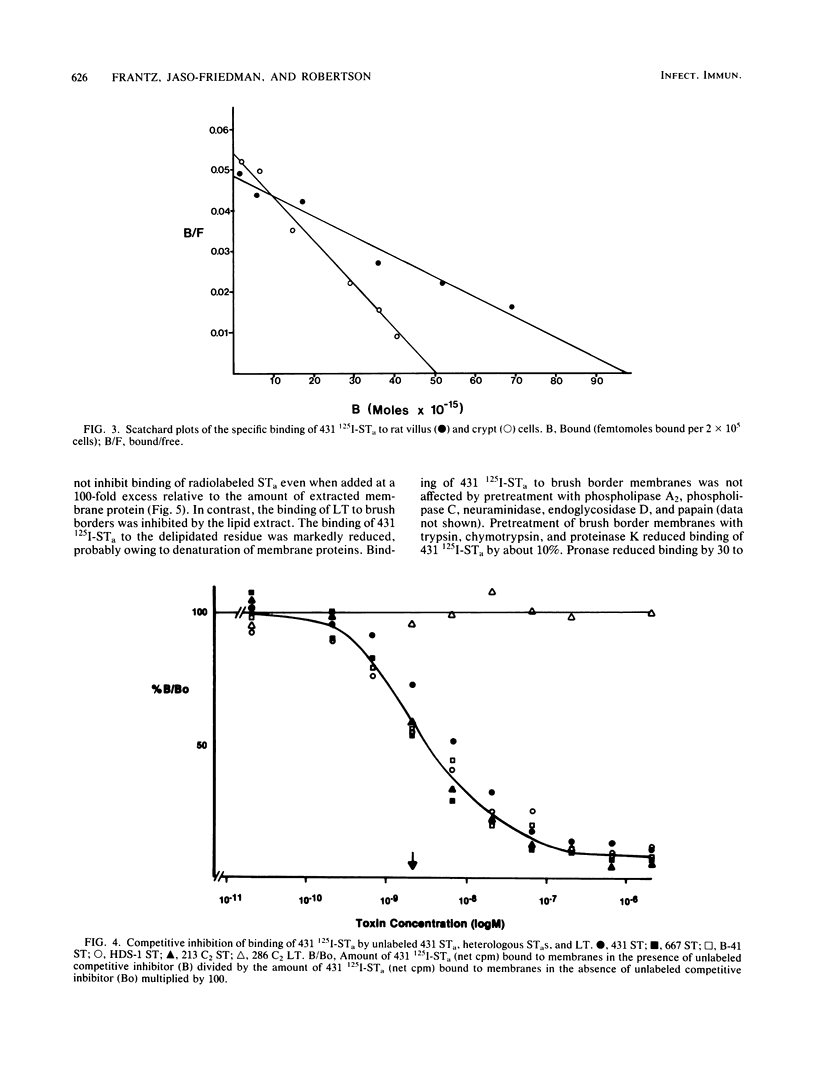

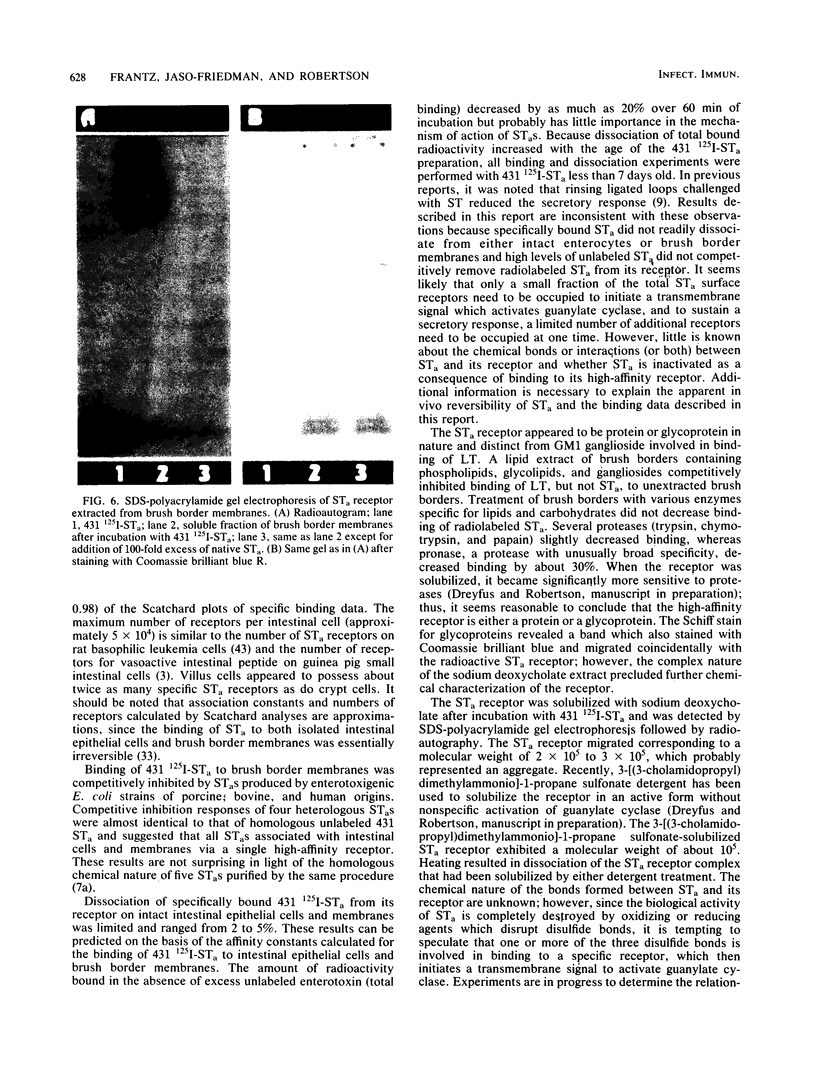
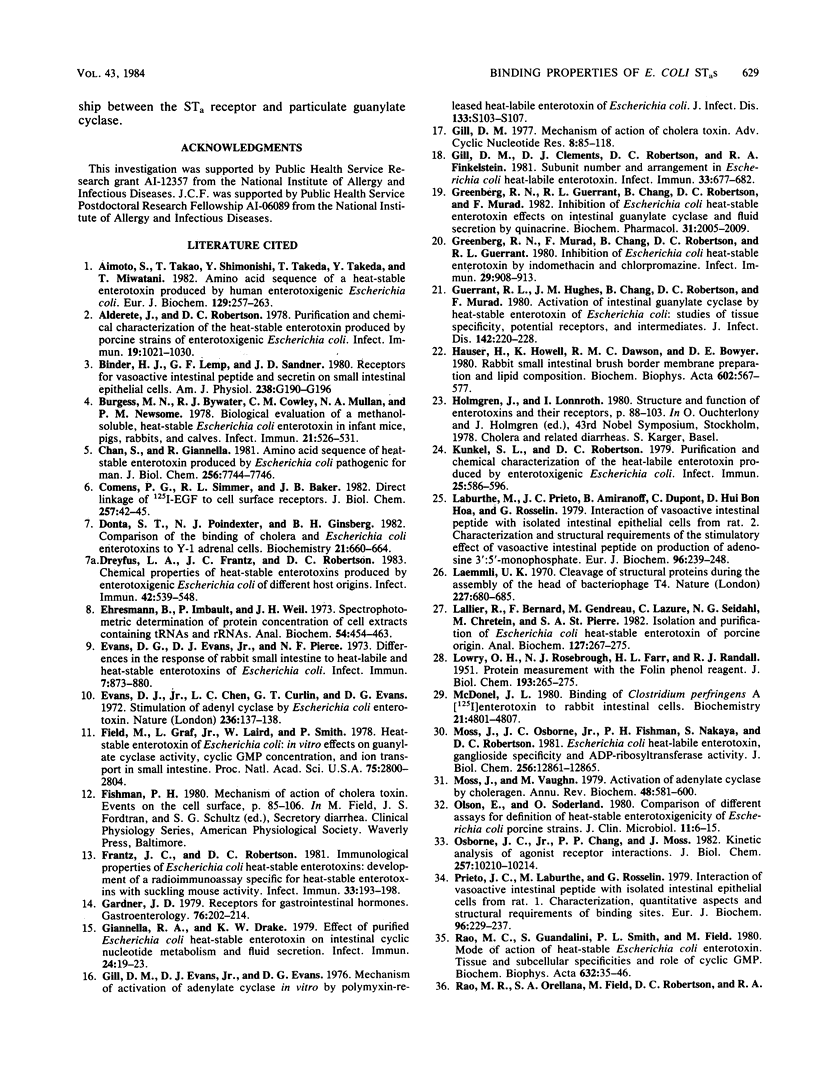
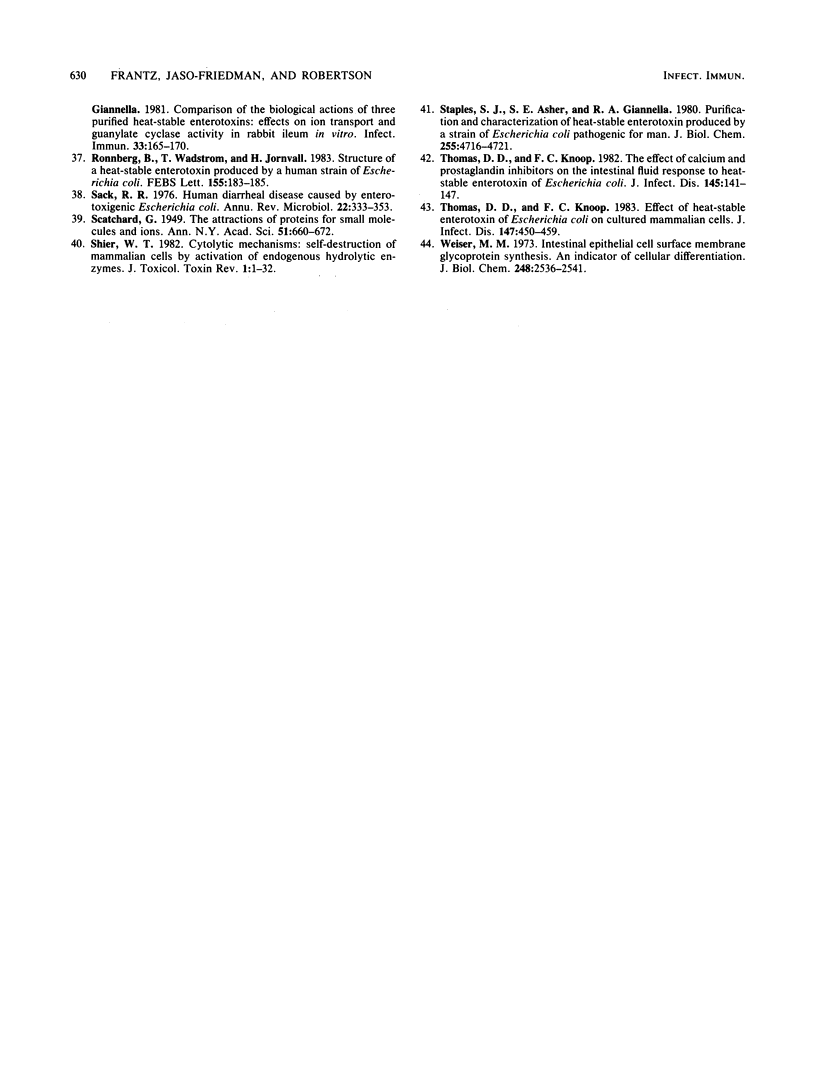
Images in this article
Selected References
These references are in PubMed. This may not be the complete list of references from this article.
- Aimoto S., Takao T., Shimonishi Y., Hara S., Takeda T., Takeda Y., Miwatani T. Amino-acid sequence of a heat-stable enterotoxin produced by human enterotoxigenic Escherichia coli. Eur J Biochem. 1982 Dec 15;129(2):257–263. doi: 10.1111/j.1432-1033.1982.tb07047.x. [DOI] [PubMed] [Google Scholar]
- Alderete J. F., Robertson D. C. Purification and chemical characterization of the heat-stable enterotoxin produced by porcine strains of enterotoxigenic Escherichia coli. Infect Immun. 1978 Mar;19(3):1021–1030. doi: 10.1128/iai.19.3.1021-1030.1978. [DOI] [PMC free article] [PubMed] [Google Scholar]
- Binder H. J., Lemp G. F., Gardner J. D. Receptors for vasoactive intestinal peptide and secretin on small intestinal epithelial cells. Am J Physiol. 1980 Mar;238(3):G190–G196. doi: 10.1152/ajpgi.1980.238.3.G190. [DOI] [PubMed] [Google Scholar]
- Burgess M. N., Bywater R. J., Cowley C. M., Mullan N. A., Newsome P. M. Biological evaluation of a methanol-soluble, heat-stable Escherichia coli enterotoxin in infant mice, pigs, rabbits, and calves. Infect Immun. 1978 Aug;21(2):526–531. doi: 10.1128/iai.21.2.526-531.1978. [DOI] [PMC free article] [PubMed] [Google Scholar]
- Chan S. K., Giannella R. A. Amino acid sequence of heat-stable enterotoxin produced by Escherichia coli pathogenic for man. J Biol Chem. 1981 Aug 10;256(15):7744–7746. [PubMed] [Google Scholar]
- Comens P. G., Simmer R. L., Baker J. B. Direct linkage of 125I-EGF to cell surface receptors. A useful artifact of chloramine-T treatment. J Biol Chem. 1982 Jan 10;257(1):42–45. [PubMed] [Google Scholar]
- Donta S. T., Poindexter N. J., Ginsberg B. H. Comparison of the binding of cholera and Escherichia coli enterotoxins to Y1 adrenal cells. Biochemistry. 1982 Feb 16;21(4):660–664. doi: 10.1021/bi00533a011. [DOI] [PubMed] [Google Scholar]
- Dreyfus L. A., Frantz J. C., Robertson D. C. Chemical properties of heat-stable enterotoxins produced by enterotoxigenic Escherichia coli of different host origins. Infect Immun. 1983 Nov;42(2):539–548. doi: 10.1128/iai.42.2.539-548.1983. [DOI] [PMC free article] [PubMed] [Google Scholar]
- Ehresmann B., Imbault P., Weil J. H. Spectrophotometric determination of protein concentration in cell extracts containing tRNA's and rRNA's. Anal Biochem. 1973 Aug;54(2):454–463. doi: 10.1016/0003-2697(73)90374-6. [DOI] [PubMed] [Google Scholar]
- Evans D. G., Evans D. J., Jr, Pierce N. F. Differences in the response of rabbit small intestine to heat-labile and heat-stable enterotoxins of Escherichia coli. Infect Immun. 1973 Jun;7(6):873–880. doi: 10.1128/iai.7.6.873-880.1973. [DOI] [PMC free article] [PubMed] [Google Scholar]
- Evans D. J., Jr, Chen L. C., Curlin G. T., Evans D. G. Stimulation of adenyl cyclase by Escherichia coli enterotoxin. Nat New Biol. 1972 Apr 5;236(66):137–138. doi: 10.1038/newbio236137a0. [DOI] [PubMed] [Google Scholar]
- Field M., Graf L. H., Jr, Laird W. J., Smith P. L. Heat-stable enterotoxin of Escherichia coli: in vitro effects on guanylate cyclase activity, cyclic GMP concentration, and ion transport in small intestine. Proc Natl Acad Sci U S A. 1978 Jun;75(6):2800–2804. doi: 10.1073/pnas.75.6.2800. [DOI] [PMC free article] [PubMed] [Google Scholar]
- Frantz J. C., Robertson D. C. Immunological properties of Escherichia coli heat-stable enterotoxins: development of a radioimmunoassay specific for heat-stable enterotoxins with suckling mouse activity. Infect Immun. 1981 Jul;33(1):193–198. doi: 10.1128/iai.33.1.193-198.1981. [DOI] [PMC free article] [PubMed] [Google Scholar]
- Gardner J. D. Receptors for gastrointestinal hormones. Gastroenterology. 1979 Jan;76(1):202–214. [PubMed] [Google Scholar]
- Giannella R. A., Drake K. W. Effect of purified Escherichia coli heat-stable enterotoxin on intestinal cyclic nucleotide metabolism and fluid secretion. Infect Immun. 1979 Apr;24(1):19–23. doi: 10.1128/iai.24.1.19-23.1979. [DOI] [PMC free article] [PubMed] [Google Scholar]
- Gill D. M., Clements J. D., Robertson D. C., Finkelstein R. A. Subunit number and arrangement in Escherichia coli heat-labile enterotoxin. Infect Immun. 1981 Sep;33(3):677–682. doi: 10.1128/iai.33.3.677-682.1981. [DOI] [PMC free article] [PubMed] [Google Scholar]
- Gill D. M. Mechanism of action of cholera toxin. Adv Cyclic Nucleotide Res. 1977;8:85–118. [PubMed] [Google Scholar]
- Greenberg R. N., Guerrant R. L., Chang B., Robertson D. C., Murad F. Inhibition of Escherichia coli heat-stable enterotoxin effects on intestinal guanylate cyclase and fluid secretion by quinacrine. Biochem Pharmacol. 1982 Jun 1;31(11):2005–2009. doi: 10.1016/0006-2952(82)90413-0. [DOI] [PubMed] [Google Scholar]
- Greenberg R. N., Murad F., Chang B., Robertson D. C., Guerrant R. L. Inhibition of Escherichia coli heat-stable enterotoxin by indomethacin and chlorpromazine. Infect Immun. 1980 Sep;29(3):908–913. doi: 10.1128/iai.29.3.908-913.1980. [DOI] [PMC free article] [PubMed] [Google Scholar]
- Guerrant R. L., Hughes J. M., Chang B., Robertson D. C., Murad F. Activation of intestinal guanylate cyclase by heat-stable enterotoxin of Escherichia coli: studies of tissue specificity, potential receptors, and intermediates. J Infect Dis. 1980 Aug;142(2):220–228. doi: 10.1093/infdis/142.2.220. [DOI] [PubMed] [Google Scholar]
- Hauser H., Howell K., Dawson R. M., Bowyer D. E. Rabbit small intestinal brush border membrane preparation and lipid composition. Biochim Biophys Acta. 1980 Nov 18;602(3):567–577. doi: 10.1016/0005-2736(80)90335-1. [DOI] [PubMed] [Google Scholar]
- Kunkel S. L., Robertson D. C. Purification and chemical characterization of the heat-labile enterotoxin produced by enterotoxigenic Escherichia coli. Infect Immun. 1979 Aug;25(2):586–596. doi: 10.1128/iai.25.2.586-596.1979. [DOI] [PMC free article] [PubMed] [Google Scholar]
- LOWRY O. H., ROSEBROUGH N. J., FARR A. L., RANDALL R. J. Protein measurement with the Folin phenol reagent. J Biol Chem. 1951 Nov;193(1):265–275. [PubMed] [Google Scholar]
- Laburthe M., Prieto J. C., Amiranoff B., Dupont C., Hui Bon Hoa D., Rosselin G. Interaction of vasoactive intestinal peptide with isolated intestinal epithelial cells from rat. 2. Characterization and structural requirements of the stimulatory effect of vasoactive intestinal peptide on production of adenosine 3':5'-monophosphate. Eur J Biochem. 1979 May 15;96(2):239–248. doi: 10.1111/j.1432-1033.1979.tb13034.x. [DOI] [PubMed] [Google Scholar]
- Laemmli U. K. Cleavage of structural proteins during the assembly of the head of bacteriophage T4. Nature. 1970 Aug 15;227(5259):680–685. doi: 10.1038/227680a0. [DOI] [PubMed] [Google Scholar]
- Lallier R., Bernard F., Gendreau M., Lazure C., Seidah N. G., Chrétien M., St-Pierre S. A. Isolation and purification of Escherichia coli heat-stable enterotoxin of porcine origin. Anal Biochem. 1982 Dec;127(2):267–275. doi: 10.1016/0003-2697(82)90171-3. [DOI] [PubMed] [Google Scholar]
- McDonel J. L. Binding of Clostridium perfringens [125I]enterotoxin to rabbit intestinal cells. Biochemistry. 1980 Oct 14;19(21):4801–4807. doi: 10.1021/bi00562a014. [DOI] [PubMed] [Google Scholar]
- Moss J., Osborne J. C., Jr, Fishman P. H., Nakaya S., Robertson D. C. Escherichia coli heat-labile enterotoxin. Ganglioside specificity and ADP-ribosyltransferase activity. J Biol Chem. 1981 Dec 25;256(24):12861–12865. [PubMed] [Google Scholar]
- Moss J., Vaughan M. Activation of adenylate cyclase by choleragen. Annu Rev Biochem. 1979;48:581–600. doi: 10.1146/annurev.bi.48.070179.003053. [DOI] [PubMed] [Google Scholar]
- Olsson E., Söderlind O. Comparison of different assays for definition of heat-stable enterotoxigenicity of Escherichia coli porcine strains. J Clin Microbiol. 1980 Jan;11(1):6–15. doi: 10.1128/jcm.11.1.6-15.1980. [DOI] [PMC free article] [PubMed] [Google Scholar]
- Osborne J. C., Jr, Chang P. P., Moss J. Kinetic analysis of agonist-receptor interactions. Model for the "irreversible" binding of choleragen to human fibroblasts. J Biol Chem. 1982 Sep 10;257(17):10210–10214. [PubMed] [Google Scholar]
- Prieto J. C., Laburthe M., Rosselin G. Interaction of vasoactive intestinal peptide with isolated intestinal epithelial cells from rat. 1. Characterization, quantitative aspects and structural requirements of binding sites. Eur J Biochem. 1979 May 15;96(2):229–237. doi: 10.1111/j.1432-1033.1979.tb13033.x. [DOI] [PubMed] [Google Scholar]
- Rao M. C., Guandalini S., Smith P. L., Field M. Mode of action of heat-stable Escherichia coli enterotoxin. Tissue and subcellular specificities and role of cyclic GMP. Biochim Biophys Acta. 1980 Sep 17;632(1):35–46. doi: 10.1016/0304-4165(80)90247-0. [DOI] [PubMed] [Google Scholar]
- Rao M. C., Orellana S. A., Field M., Robertson D. C., Giannella R. A. Comparison of the biological actions of three purified heat-stable enterotoxins: effects on ion transport and guanylate cyclase activity in rabbit ileum in vitro. Infect Immun. 1981 Jul;33(1):165–170. doi: 10.1128/iai.33.1.165-170.1981. [DOI] [PMC free article] [PubMed] [Google Scholar]
- Rönnberg B., Wadström T., Jörnvall H. Structure of a heat-stable enterotoxin produced by a human strain of Escherichia coli. Differences from the toxin of another human strain suggest the presence of compensated amino acid exchanges. FEBS Lett. 1983 May 8;155(2):183–186. doi: 10.1016/0014-5793(82)80598-x. [DOI] [PubMed] [Google Scholar]
- Staples S. J., Asher S. E., Giannella R. A. Purification and characterization of heat-stable enterotoxin produced by a strain of E. coli pathogenic for man. J Biol Chem. 1980 May 25;255(10):4716–4721. [PubMed] [Google Scholar]
- Thomas D. D., Knoop F. C. Effect of heat-stable enterotoxin of Escherichia coli on cultured mammalian cells. J Infect Dis. 1983 Mar;147(3):450–459. doi: 10.1093/infdis/147.3.450. [DOI] [PubMed] [Google Scholar]
- Thomas D. D., Knoop F. C. The effect of calcium and prostaglandin inhibitors on the intestinal fluid response to heat-stable enterotoxin of Escherichia coli. J Infect Dis. 1982 Feb;145(2):141–147. doi: 10.1093/infdis/145.2.141. [DOI] [PubMed] [Google Scholar]
- Weiser M. M. Intestinal epithelial cell surface membrane glycoprotein synthesis. I. An indicator of cellular differentiation. J Biol Chem. 1973 Apr 10;248(7):2536–2541. [PubMed] [Google Scholar]



